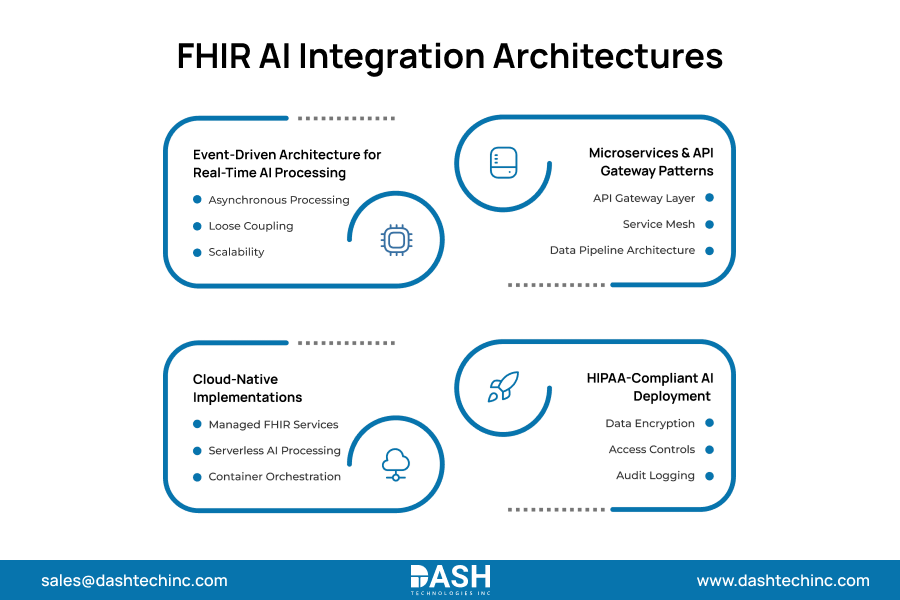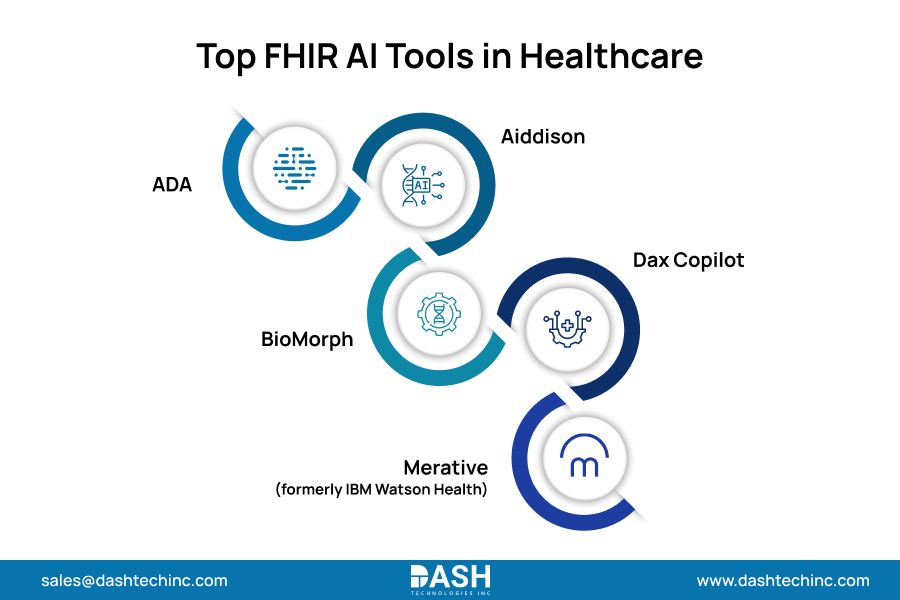The Future of AI in Healthcare : Architectures for FHIR Interoperability
AI in healthcare has evolved from being a theoretical concept to a requirement. Healthcare data already makes up about 30% of all global data. Providers are moving from old, isolated systems toward digital platforms that focus on patients. In this shift, AI tools and the FHIR API (Fast Healthcare Interoperability Resources) work hand in glove to create true healthcare interoperability.
This blog post will explore modern architectures that support powerful FHIR AI integration. We’ll look at AI tools and how the FHIR healthcare API boosts AI for clinical data integration.
The Convergence of AI and Healthcare Interoperability
Many healthcare systems still run in silos. Records, tests, and patient histories often stay locked in separate databases. This leads to:
- Redundant testing and higher healthcare costs.
- Gaps in care due to incomplete data.
- Manual work that bogs down providers and administrators.
- Medical errors and negative patient outcomes.
Healthcare interoperability fixes these issues. The idea is simple: make sure the data that needs to move around for care can do so securely and reliably across platforms and providers. The market expects standards that guarantee that health information can follow the individual, both for health centers and large hospital chains alike, regardless of location.
The challenge is not in building AI solutions, but in deploying them within the complexity of healthcare delivery, where data silos and interoperability requirements, as well as regulatory compliance, present considerable barriers to implementation.
FHIR acts as the bridge that allows AI systems to access, process, and share healthcare data across platforms and organizations without disruption. Standardization is so crucial because legacy healthcare systems often use proprietary formats that limit data sharing and thus the ability of AI tools to live up to their potential.
The integration of AI for clinical data integration through FHIR has already demonstrated a measurable impact. Research shows that FHIR-based analytics frameworks can increase data interoperability from 11% to 66%.
Let’s Shape the Future of AI in Healthcare
We partner with healthcare leaders to design future-ready AI architectures that drive secure, scalable interoperability.
Start the Conversation
The Role of FHIR in Data Exchange
FHIR represents the modern standard for health information exchange interoperability. Created by HL7 International, FHIR specifies how medical information can be securely stored, accessed, and shared in a scalable manner. The primary benefits of the FHIR healthcare API are:
Resource-based architecture: Under a resource-based approach, data is decomposed into atomic “resources” such as Patient, Observation, and Medication, allowing detailed information to flow freely.
Web-Ready APIs: FHIR employs RESTful APIs, with data formats such as JSON and XML, allowing browser and mobile integration at high speeds.
Extensibility: Extensions may be developed by organizations to address specialized workflows or specialty datasets without compromising compliance with standards.
Built-in security: Using OAuth 2.0 and Role-based access controls for easy steps to secure health data.
Global regulatory support: FHIR is referenced by the ONC Cures Act and other international frameworks, aligning healthcare IT with legal requirements.
Modern FHIR AI Integration Architectures

Event-Driven Architecture for Real-Time AI Processing
The current application of FHIR integration is leaning towards event-driven architecture, which supports real-time processing of data and AI inference. The approach has several important advantages in healthcare environments:
Asynchronous Processing: AI applications for healthcare can process information without occupying system resources and continue working even when system resources are at their peak. This is especially required for clinical decision support systems that need to address immediate patient requirements without hindering the organization’s workflow.
Loose Coupling: Services are independent, so that each AI component alone is updated, scaled, or replaced without affecting the entire system. This versatility in AI in healthcare proves helpful, as AI tools in healthcare may differ between departments.
Scalability: Scalability enables every service to scale demand-based, which is an efficient means of deploying AI solutions that can cope with the variable workloads typical in healthcare settings.
Microservices and API Gateway Patterns
Successful implementations use interface engines that span the gap between new and old protocols and hence provide a common API layer. Such architecture generally has:
API Gateway Layer: Manages authentication, rate limiting, and routing of the requests to the appropriate FHIR services with proper security standards required for healthcare data.
Service Mesh: Provides secure communication between the microservices that make up the distributed AI system, while HIPAA compliance and data integrity are critical between the components of the AI for the clinical data integration process.
Data Pipeline Architecture: Real-time data ingestion from multiple healthcare sources, such as wearables, medical devices, and EHRs, into standardized FHIR formats for AI processing is made easier by data pipeline architecture.
Cloud-Native Implementations
Cloud platforms that support FHIR implementation and advanced AI capabilities are gaining popularity in modern deployments. For AI in healthcare cloud-native architecture provides:
Managed FHIR Services: Services like Azure FHIR healthcare API and Google Cloud Healthcare API provide completely managed FHIR servers with built-in security, compliance, and scalability.
Serverless AI Processing: Functions-as-a-Service designs make it possible for economical AI in healthcare model deployment that scales automatically with demand.
Container Orchestration: Kubernetes-based deployments offer high scalability and management features for AI workloads with FHIR compliance.
HIPAA-Compliant AI Deployment
Healthcare Interoperability efforts should factor in strict privacy and security needs. Core architectural elements include:
Data Encryption: FHIR resources are fully encrypted in transit and at rest. Encryption extends to AI training datasets and model outputs.
Access Controls: Role-based access control makes sure that AI tools in healthcare only access required patient data for designated use cases.
Audit Logging: Comprehensive tracking of all AI system interactions with patient data to support compliance monitoring and investigation.
Why AI Thrives on FHIR-Centric Architectures
AI tools in healthcare, like machine learning, natural language processing (NLP), robotics, and analytics, can only be as smart as the data that they are given. By making enterprise data available at scale, at high fidelity, and in a structured, interoperable format, FHIR allows AI models to be trained on the right inputs and provide actionable outcomes.
AI for clinical data integration enables:
- Automated data mapping & transformation: AI facilitates automated transformation of legacy and unstructured data into FHIR-compliant versions, accelerating interoperability initiatives dramatically.
- NLP for unstructured clinical text: AI for NLP can help extract important patient information from physician notes, scanned documents, or PDFs into a more structured format and map it to FHIR resources from “free text”.
- Predictive analytics: AI tools built on FHIR API can predict patient risks (readmission, sepsis) and potential adverse events much earlier, optimize care plans, and flag anomalies in near real time.
Leading AI Tools in Healthcare Using FHIR

Ada and Aiddison: AI-powered diagnostic tools, highly integrated via APIs for seamless workflow adoption.
BioMorph and Dax Copilot: Clinical NLP tools for documentation and workflow augmentation on FHIR data
Merative (formerly IBM Watson Health): Predictive analytics and population health tools leveraging FHIR APIs for unified data views.
How Dash Technologies Can Accelerate Your FHIR AI Integration Journey
Integration is just the start of AI in healthcare. To get the most out of AI in healthcare and interoperability, you need an experienced partner. We are your trusted end-to-end FHIR and AI integration partner. We make FHIR data exchange seamless and secure. It brings smart automation to your entire healthcare enterprise. Reach out to us for a consultation. Let’s explore how we can turn challenges into results.
About Dash

Dash Technologies Inc.
We’re technology experts with a passion for bringing concepts to life. By leveraging a unique, consultative process and an agile development approach, we translate business challenges into technology solutions Get in touch.







